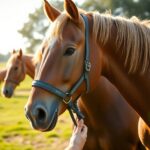You wake up before the sun rises, knowing that a challenging but rewarding day lies ahead. As a horse trainer, your day is filled with hard work, patience, and a deep love for these majestic animals. From mucking out stalls to training sessions and caring for their every need, your passion drives you forward. Each day brings new challenges and joys, making your role as a horse trainer truly unique and fulfilling.

Morning Routine
Arrival at the Stables
Morning breaks as you arrive at the stables, the cool air filled with the sounds of whinnies from the eager horses awaiting your care. The smell of fresh hay greets you as you walk through the rows of familiar stalls, each horse poking their head out to greet you with curiosity. You start your day by checking on each horse, ensuring they have a comfortable night’s rest.
Feeding and Grooming
The morning feeding and grooming routine is a crucial aspect of a horse trainer’s day. You meticulously measure out each horse’s feed, taking into account their individual dietary needs. As you rake out the stalls, the horses nuzzle you affectionately, eager for their breakfast. After they have eaten, you begin the grooming process, brushing their coats to a shine, picking out their hooves, and checking for any signs of injuries or skin conditions.
A well-fed and groomed horse is not only healthier but also more receptive to training. This daily routine allows you to establish trust and rapport with your equine companions, setting the foundation for a successful day of training ahead.

Training Sessions
Some of the most crucial moments in a horse trainer’s day are the training sessions with the horses. These sessions are where you work on improving the horse’s skills, strength, and behavior.
Warm-up Exercises
To begin a training session, it is vital to start with warm-up exercises. This phase helps to loosen up the horse’s muscles and joints, preventing injuries during more intense training. You might engage in activities such as lunging, trotting, and cantering to get the blood flowing and prepare the horse for the upcoming work.
Jumping and Agility Training
Agility training plays a significant role in a horse’s development. This type of training involves obstacles and courses that challenge the horse’s coordination, balance, and speed. **Jumping** exercises, in particular, are thrilling for both the horse and the trainer. They require precise timing and coordination to navigate the jumps successfully.
Training a horse to be agile and accurate in their movements not only enhances their physical abilities but also builds their confidence and trust in you as their trainer.
Behavioral Training
For some horses, behavioral training is just as important as physical training. This type of training focuses on correcting unwanted behaviors such as biting, kicking, or spooking. By using positive reinforcement techniques and consistent training, you can help the horse understand what behaviors are acceptable and build a stronger bond with them.
Understanding the psychology behind a horse’s behavior is crucial in effectively addressing any issues that may arise. By **recognizing** their body language and responses, you can tailor your training approach to suit each horse’s individual needs.

Working with Different Horses
Once again, your day as a horse trainer is filled with the excitement of working with a variety of horses, each with its unique personality, abilities, and challenges.
Young and Energetic Horses
Any trainer knows that working with young and energetic horses can be both exhilarating and demanding. These horses are full of curiosity and spirit, eager to learn and explore the world around them. Training young horses involves building trust, establishing boundaries, and introducing them to basic skills such as halter training, ground manners, and desensitization exercises.
Older and More Experienced Horses
On the other hand, working with older and more experienced horses requires a different approach. These horses have likely been trained before and have a better understanding of cues and rider expectations. However, they may also have developed bad habits or physical limitations that need to be addressed. As a trainer, your role is to assess their individual needs, tailor training programs to suit their abilities, and help them maintain their skills and fitness level.
Horses with Special Needs
On some occasions, you may come across horses with special needs, such as physical disabilities, behavioral issues, or past traumas that require extra care and attention.
Horses with Special Needs
On these occasions, your expertise and patience are truly put to the test as you work to gain the trust and cooperation of these vulnerable animals. For instance, a horse with a past traumatic experience may require slow and gentle desensitization techniques to help them overcome their fears and build confidence. Your ability to adapt and approach each horse with empathy and understanding makes all the difference in their progress and well-being.
Challenges and Setbacks
Despite your passion for training horses, there are inevitable challenges and setbacks that you will face in your journey as a horse trainer. From injuries and illnesses to difficult temperaments and training plateaus, navigating these obstacles is part of the daily life of a horse trainer.
Dealing with Injuries and Illnesses
An integral part of being a horse trainer is caring for the well-being of your equine partners. **Injuries** and illnesses can occur unexpectedly, disrupting your training schedule and requiring patience and expertise to handle. Whether it’s a sprained leg, a respiratory infection, or a more serious condition, **your ability to quickly diagnose, treat, and rehabilitate** your horse is crucial in ensuring their health and future performance.
Managing Difficult Temperaments
Dealing with horses with difficult temperaments can significantly test your patience and skill as a trainer. **You must have a deep understanding of equine behavior** to effectively work with stubborn, anxious, or aggressive horses. **Consistency, patience, and compassion** are key in gaining the trust and cooperation of these challenging equine personalities.
Dealing with a challenging horse can be both physically and mentally demanding. It is imperative to stay calm, focused, and adaptable in your training approach to **establish a positive relationship** with the horse. **Seeking guidance from experienced trainers** and incorporating** different training techniques** can also be beneficial in managing difficult temperaments successfully.
Overcoming Training Plateaus
The training journey with a horse is not always linear, and **plateaus in progress** are common in the world of horse training. The monotony of daily routines, lack of motivation, or a stale training regimen can lead to **stagnation in your horse’s development**. **Identifying the root cause** of the plateau, whether it’s physical, mental, or emotional, is crucial in overcoming this hurdle.
The ability to **adapt your training methods**, introduce new exercises, and set realistic goals can help you and your horse push through training plateaus. **Consistent evaluation** of your training program and **making adjustments** as needed will help keep your horse engaged and progressing towards your training objectives.
Injuries or illnesses, especially in horses, can be very dangerous and may have long-lasting effects on their performance. Therefore, it is crucial to have a keen eye for any signs of discomfort or distress in your equine partners. Regular veterinary check-ups, appropriate rest periods, and **rehabilitation programs** are imperative in ensuring the **full recovery** of your horse.

The Importance of Patience and Trust
All successful horse trainers know that patience and trust are key components in building a strong relationship with any horse. Patience is crucial when working with horses, as it takes time for them to learn new behaviors and adapt to training techniques. Trust is equally important, as horses are highly intuitive animals and can sense when someone is unsure or afraid.
Building Relationships with Horses
One of the first steps in building a relationship with a horse is earning their trust. This involves spending time with the horse, getting to know their personality, and building a bond based on mutual respect. By approaching the horse with a calm and confident demeanor, you can start to establish a foundation of trust.
Establishing Clear Communication
Horses communicate through body language, vocal cues, and subtle gestures. As a trainer, it’s crucial to learn how to read these signals and respond accordingly. By establishing clear communication with the horse, you can create a harmonious partnership built on understanding and trust.
One effective way to communicate with a horse is through consistent cues and rewards. When the horse responds correctly to a cue, reward them immediately with praise or a treat. This positive reinforcement helps the horse understand what is expected of them and encourages them to continue learning.
Earning Trust and Respect
With consistent and fair training methods, you can earn the trust and respect of the horse. By setting clear boundaries and being consistent in your actions, you show the horse that you are a reliable and trustworthy leader. This helps to build a strong foundation for a successful training relationship.
A Typical Afternoon
Cooling Down and Relaxation
One of the most crucial parts of your afternoon routine as a horse trainer is the cooling down and relaxation period after a rigorous training session. This is the time when you allow your horse to recover from the workout and help prevent any muscle soreness or injuries. You might take your horse for a gentle walk, allowing it to stretch its legs and cool down gradually.
Reviewing Progress and Planning Ahead
Typically, after the cooling down period, you would spend some time reviewing progress and planning ahead for your horse’s training regimen. You may reflect on how the training session went, what improvements your horse made, and what areas still need work. This reflection time is crucial for adapting your training program to suit your horse’s needs better.
During this time, you might also plan out the next training sessions, set new goals, and adjust the training intensity or focus based on your observations. It’s necessary to have a clear plan and vision for your horse’s progress to ensure consistent growth and development.
Maintaining Equipment and Facilities
One of the less glamorous but equally important tasks in a typical afternoon as a horse trainer is maintaining equipment and facilities. This involves cleaning and checking your tack, grooming supplies, and the training area to ensure everything is in good condition and safe for your horse.
Regular maintenance not only prolongs the lifespan of your equipment but also ensures the safety and well-being of your horse during training sessions. By keeping your gear in top shape, you can prevent accidents or discomfort for you and your horse.
Conclusion
So, as you have learned about the typical day in the life of a horse trainer, you understand the dedication, passion, and hard work required to excel in this profession. From early mornings at the stables to late nights grooming and caring for horses, a horse trainer’s day is filled with unique challenges and rewarding moments. It takes a special individual to handle the physical demands and emotional connections that come with working closely with these majestic animals.
Keep in mind, being a horse trainer is not just a job, it’s a lifestyle. It’s about building trust, communication, and understanding with your equine partners. Whether you’re training for competition, rehabilitation, or just the love of working with horses, each day brings new experiences and opportunities for growth. So next time you see a horse trainer at work, take a moment to appreciate the dedication and skill it takes to succeed in this demanding yet incredibly fulfilling profession.
FAQ
Q: What qualifications are needed to become a horse trainer?
A: To become a horse trainer, it is recommended to have a deep understanding of horse behavior, anatomy, and training techniques. Many trainers start by working with experienced professionals to gain hands-on experience before venturing out on their own.
Q: What does a typical day look like for a horse trainer?
A: A day in the life of a horse trainer usually begins early in the morning with feeding and grooming the horses. Throughout the day, trainers work on exercises to improve the horses’ performance, provide care and attention to the animals, and communicate with owners about their progress.
Q: How do horse trainers build relationships with the horses they work with?
A: Building a strong relationship with a horse is key for a trainer. This involves spending time with the animal, understanding their personality and behavior, and using positive reinforcement techniques to develop trust and respect between trainer and horse.
Q: What are some challenges that horse trainers face in their profession?
A: Horse trainers often face challenges such as dealing with difficult or unruly horses, managing the physical demands of working with large animals, and balancing the needs of various clients and horses in their care. Weather conditions and financial limitations can also present challenges in this profession.
Q: How can someone interested in becoming a horse trainer get started in the field?
A: To begin a career as a horse trainer, it is helpful to start by gaining experience working with horses through internships, apprenticeships, or volunteering at a stable or training facility. Developing a strong foundation of knowledge and skills in horse care and training is vital for success in this profession.










